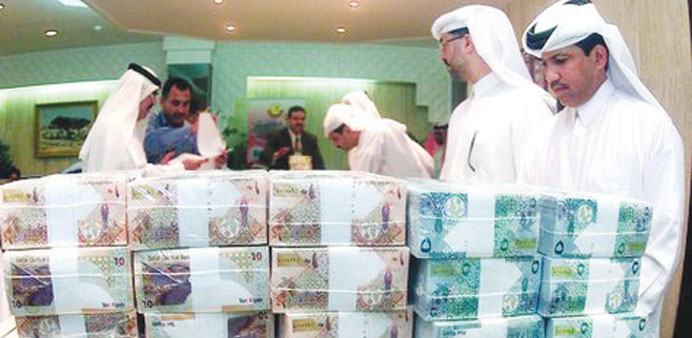By Santhosh V Perumal/Business Reporter
Healthy economic growth prospects for the Gulf region this year, supported by high oil prices, should keep demand for bank credit high and expand banks’ earnings, according to global credit rating agency Standard & Poor’s.
Moreover, a low interest rate regime, healthy investor demand and “accommodative” pricing should prompt the Gulf lenders to tap debt markets to issue long-term paper in 2013, S&P said in a report.
Anticipating a dual-speed pattern of growth of banks in the Gulf Co-operation Council (GCC) region, S&P said in Saudi Arabia and Qatar “we think that strong bank lending will be the main impetus for fast growth in bank revenues”.
Banks in these countries will likely take advantage of healthy domestic conditions to deploy their assets toward lending, notably on corporate and infrastructure projects, it said.
Expecting that credit growth in Qatar will remain strong, albeit at a slower pace, the report said large public sector projects are having a trickle-down effect on the corporate sector and fuelling credit demand but “we see some slowdown in these projects in 2013”.
Despite some potential margin compression on Qatari banks due to declining asset yields, “we therefore expect Qatari banks will continue to generate strong revenues”, it added.
Gulf banks’ traditionally strong capitalisation and healthy funding and liquidity should continue to support their recovery, according to the agency.
“We expect that some of the banks in the region will carry on making acquisitions in the Middle East and North Africa this year to diversify their business positions, and take advantage of low asset valuations. They are also likely to continue taking advantage of historically low interest rates to issue debt on the capital markets,” it said.
Historically low interest rates and healthy investor demand should continue to incentivise the Gulf banks to tap capital markets to issue long-term paper in 2013, it said.
Additionally, Gulf banks continue to operate with a healthy funding profile, on a global scale as evidenced by a loans-to-deposits ratio ranging from about 80% and 110% and deposits to assets of between 55% and 73% in 2012 at system level.
In 2012, Gulf banks were able to capitalise on the appetite in regional and international debt capital markets for long-term issuances at attractive prices, it said, adding issuances more than doubled to $15.3bn in 2012.
The bulk of these were in the form of five-year bonds and sukuk, while the dollar-weighted-average tenor for the debt issued was 5.6 years.
“We expect that the banks will continue to tap debt markets this year to benefit from current accommodative pricing conditions. What is more, we anticipate that their options for allocating their assets will further widen as corporate and sovereign entities in the region also increase their issuance,” it said.
In spite of the weak global economic outlook, S&P forecast that the GCC’s robust economic growth last year will continue in 2013, with an un-weighted average real GDP growth of 4.6%, after 5.2% in 2012.
“We nevertheless see narrower scope for production increases and think oil prices are unlikely to regain their previous dynamism, leading to a slightly slower pace of growth this year. We also expect that hydrocarbon resources will continue to dominate the region’s economies, despite Gulf sovereigns’ diversification efforts,” it said.
The large pipeline of infrastructure projects in the Gulf should translate into larger streams of corporate lending.
Fast-paced corporate lending growth in Qatar in the run-up to the 2022 World Cup, and the boom in residential retail financing in Saudi Arabia following the authorities’ decision to open up the mortgage lending market, are two notable examples.

